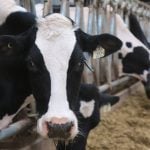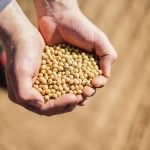If it’s true that every farmer knows how easy it is for bankers to forget that there is a real person behind the account numbers, maybe the opposite is true too.
Yes, there’s a new farmer. Today, the average farmer’s financial skills are miles beyond those of farmers 30 years ago. Our farms are more complex as well. They’re obviously bigger, and we’re all a lot more business oriented.
Is there a new banker too? And, if yes, what does it mean for agriculture? I arranged to meet RBC national ag manager Brian Little on his own turf to find out.
Read Also

The farm transition trial
For anyone affected by cancer, they have likely heard the adage that “a person doesn’t get cancer, the family does.”…
If it weren’t for the suits, Little and I could have been leaning on the back of my pickup truck when we started our conversation under an early-autumn sun. “Did you get frost two nights ago? Yup, but not too bad. The edible beans are touched on top, but they look green underneath.”
Instead we were sipping coffee surrounded by concrete, glass and granite in the shadow of the CN Tower, and our crop talk quickly switched to talk of debt.
Little tells me Canada’s farmers have become extremely good at managing debt, spurred on by the increasing value of land and quota together with historically low interest rates. Farmers are monitoring debt-to-equity ratios, he tells me. They’re running scenarios to test their vulnerability to interest rates. And with the bank’s help, they’re designing innovative new loan strategies.
Overall, Little tells me today’s farmers are better able to handle larger debt because of economies of scale and increasing asset values, plus the adoption of technology and their enhanced business skills.
Certainly they’re taking on more debt. Statistics Canada reports Canadian farmers continue to take on debt at an unprecedented rate, posting a 5.2 per cent jump in 2008 to a record high of $58 billion.
Similarly, Little says RBC’s agriculture business will likely increase by four to five per cent this year, reflecting the continuing strength of the farm sector. As key drivers, Little points to increases in quota values in the supply-managed sectors, refinancing in the pork industry and a couple of years of good grain prices.
For the same reasons, Little expects the ag loan business to slow down next year due to a forced decrease in dairy quota this summer, a restructured red meat industry and softening grain prices.
Going into 2010, RBC will be looking off-farm to expand their loans to agribusinesses that sell to or buy from farmers. Another burgeoning area for their division is agricultural biotechnology. RBC is actively positioning its banking services for biotech companies in hubs such as Guelph.
Interest rates
With prime interest rates at an all-time low, farmers have a larger carrying capacity. All that could change quickly, however. Little says he’s concerned that interest rates could rise with inflation and Canadian farmers need to be aware of that threat. “We could go up two per cent in a year,” Little says. “All the Bank of Canada is saying is that we’ll likely hold until February 2010.”
Does your current ratio still sing if you have to service your debt with six or even eight per cent interest? RBC’s risk management groups do sensitivity analysis on financial plans to see if they’ll cash flow at six per cent.
“My concern is that interest rates have been low long enough that we (Canadian farmers) have developed a level of comfort with it,” says Little.
Are we headed to the 20-plus per cent interest rates that shredded the farmer sector in the 70s? “I don’t think so,” says Little. “We’re in a better position in terms of the whole economy, but farmers still need to be prepared.”
One of RBC’s largest competitors is lending with interest-only repayments for five years, and a 20-year amortization for quota. That’s tough to compete against but it’s not a strategy that Little dares to replicate. “What happens if something goes wrong at WTO, or if interest rates increase?”
With the equity they’ve built up over the years, plus the effect of increasing land values, most established farms can absorb incremental interest hikes, Little says. Overall, he points out, our $58 billion in debt means Canada’s farms have 87 per cent equity, compared to 13 per cent debt.
Additionally, the total value of assets that can be used as security has increased. With my table-napkin math, the total net assets held by Canadian farmers rose to $388 billion in 2008. Any way you cut into it, that’s one big chunk of hard security.
RBC uses only 75 per cent of the value of land and 50 per cent of the value of quota as security or net realizable value. “RBC has always done our analysis on the ability to repay,” says Little. “Our lending criteria is based on debt-servicing capacity. We’re not asset-based lenders.”
For quota, RBC will amortize out only 10 years. The banks like the guaranteed cash flow on quota but Little isn’t counting on quota increasing in value. “Having the value of dairy quota (in Ontario) stabilized at $25,500, that might stabilize the level of debt for Canadian farmers for a period of time,” he says.
RBC agriculture’s strategic plan is divided by sector — from greenhouses to grains — not by equity size. Little says if one sector is experiencing difficulty they try to help clients build a plan to get them through the difficulty. “How we service and analyse debt is client by client,” Little explains.
Although RBC’s core business is commodity producers, Little says there are opportunities in farming for well-run entrepreneurial small farms around urban centres, such as pick-your-own and agri-tourism ventures and “life-stylers” who don’t rely on off-farm income to support their family.
Then there are smaller, younger farmers
who grow commodities, work and have income off the farm. They gross less than $250,000 but they’re leaders in their communities and farm organizations, and are growing their farms. “We want to reach out to these people so when they’re in a position to move into full-time farming, we can help them achieve their goals,” says Little. “They’re the future, the commodity producers’ farm team.”
DEBT STRUCTURE
Farmers and account managers are getting more creative at how they structure loans. “Every situation is different,” says Little, scheduled to retire at the end of December. “There’s no template to be used in this industry.”
Since interest rates have been low, there’s been a trend to using variable-rate loans and larger operating lines for agriculture. “Some farmers have been using variable rates to knock off as much principal as possible,” says Little.
Recently, mortgaged debt has been growing faster than non-mortgaged, mainly because supply-managed quota doesn’t have sufficient inherent security value, so account managers have been bundling it with land to increase the amortization period. That means the debt gets capitalized over longer periods, thereby making the cash flow work at higher quota prices.
That practice may have contributed to higher quota prices. “Add extended amortization with low interest rates and you tend to pay more,” says Little.
“We’re in a very competitive market so we need to work with our customers,” says Little. This means being consistent, showing them new loan options and structures and helping them through difficulties.
FINANCIAL SKILLS
Farmers today do have much better financial management. Little has been working for the ag division of RBC since 1976. He’s seen massive changes in agriculture, but the most significant is the financial ability of the farmer. “Financial reporting and record keeping has tightened up significantly since 1968,” says Little. “Farmers traditionally used to file financial reports for tax purposes — now that’s secondary.”
“Many of the MIS (management information systems) used by farmers today are very detailed and very complex,” says Little. They’re designed to help them make management decisions, with ratios and charts literally at their fingertips.
“The industry has evolved and the record keeping has tightened up,” Little says. “You’ve got to manage well in today’s economy.”
Not only do we need to be financially astute, we can be. Like the rest of Canada’s population, farmers today are better educated and more computer savvy. Moreover, new equipment technology and innovations have made farming less labour intensive, so farmers have more time to manage the financial part of their businesses.
SIZE MATTERS — FOR BANKS TOO
Canadian farmers are leading edge when it comes to technology, says Little. “Our producers are, in my view, some of the most technically innovative people in the world.”
A higher percentage of RBC’s farm customers use electronic services, such as online banking than in the average population.
To better service the needs of this “new” farm population, RBC has a hub system of services with ag centres and risk management groups specialized in specific sectors. Little has been leading this restructuring process since the early 1980s, when he was on the team that developed the agriculture centres structure. The first ones were in Red Deer, Alta. and Brantford, Ont., where Little was posted.
Today, RBC has 255 account managers at 55 ag centres across Canada. “We have to ensure that our account managers are skilled and stay up to date in specific areas,” says Little.
They’ve also identified that size matters when it come to bank services. RBC has a special “commercial ag loan” group to service large farms. The needs of large farms today are more commercial — more like ag businesses, says Little. Their needs are not just loans and operating lines. They need information on things like hedging, cash management, investment accounts, exporting, and foreign exchange.
Like large diversified farms producing more than one product for multiple customers, RBC likes to deal in all farming sectors. “It enables us to manage our portfolio risk,” says Little.
MANAGE CASH FLOW
Today, the factors that farmers have no control over seem to be escalating and fluct
who grow commodities, work and have income off the farm. They gross less than $250,000 but they’re leaders in their communities and farm organizations, and are growing their farms. “We want to reach out to these people so when they’re in a position to move into full-time farming, we can help them achieve their goals,” says Little. “They’re the future, the commodity producers’ farm team.”
DEBT STRUCTURE
Farmers and account managers are getting more creative at how they structure loans. “Every situation is different,” says Little, scheduled to retire at the end of December. “There’s no template to be used in this industry.”
Since interest rates have been low, there’s been a trend to using variable-rate loans and larger operating lines for agriculture. “Some farmers have been using variable rates to knock off as much principal as possible,” says Little.
Recently, mortgaged debt has been growing faster than non-mortgaged, mainly because supply-managed quota doesn’t have sufficient inherent security value, so account managers have been bundling it with land to increase the amortization period. That means the debt gets capitalized over longer periods, thereby making the cash flow work at higher quota prices.
That practice may have contributed to higher quota prices. “Add extended amortization with low interest rates and you tend to pay more,” says Little.
“We’re in a very competitive market so we need to work with our customers,” says Little. This means being consistent, showing them new loan options and structures and helping them through difficulties.
FINANCIAL SKILLS
Farmers today do have much better financial management. Little has been working for the ag division of RBC since 1976. He’s seen massive changes in agriculture, but the most significant is the financial ability of the farmer. “Financial reporting and record keeping has tightened up significantly since 1968,” says Little. “Farmers traditionally used to file financial reports for tax purposes — now that’s secondary.”
“Many of the MIS (management information systems) used by farmers today are very detailed and very complex,” says Little. They’re designed to help them make management decisions, with ratios and charts literally at their fingertips.
“The industry has evolved and the record keeping has tightened up,” Little says. “You’ve got to manage well in today’s economy.”
Not only do we need to be financially astute, we can be. Like the rest of Canada’s population, farmers today are better educated and more computer savvy. Moreover, new equipment technology and innovations have made farming less labour intensive, so farmers have more time to manage the financial part of their businesses.
SIZE MATTERS — FOR BANKS TOO
Canadian farmers are leading edge when it comes to technology, says Little. “Our producers are, in my view, some of the most technically innovative people in the world.”
A higher percentage of RBC’s farm customers use electronic services, such as online banking than in the average population.
To better service the needs of this “new” farm population, RBC has a hub system of services with ag centres and risk management groups specialized in specific sectors. Little has been leading this restructuring process since the early 1980s, when he was on the team that developed the agriculture centres structure. The first ones were in Red Deer, Alta. and Brantford, Ont., where Little was posted.
Today, RBC has 255 account managers at 55 ag centres across Canada. “We have to ensure that our account managers are skilled and stay up to date in specific areas,” says Little.
They’ve also identified that size matters when it come to bank services. RBC has a special “commercial ag loan” group to service large farms. The needs of large farms today are more commercial — more like ag businesses, says Little. Their needs are not just loans and operating lines. They need information on things like hedging, cash management, investment accounts, exporting, and foreign exchange.
Like large diversified farms producing more than one product for multiple customers, RBC likes to deal in all farming sectors. “It enables us to manage our portfolio risk,” says Little.
MANAGE CASH FLOW
Today, the factors that farmers have no control over seem to be escalating and fluct
tuating more, including weather, currency rates, trade disputes, politics and interest rates. “Better put your seatbelt on and be able to manage around it,” says Little.
“Remember a year ago when worldwide stores of wheat were only nine days and today it’s completely shifted,” says Little. “That’s how quickly things can change because there’s so much readily available information.”
Little believes farmers have become better at managing the risk of cash flow fluctuations. Pre-selling and trading accounts are commonplace. Farmers are direct selling to end-users, they have diversified into non-commodity production, and more farming families have off-farm incomes. They also include more realistic family-living costs in their price budgets.
Farmers have also invested capital to help control formerly uncontrollable factors. The number of acres irrigated and tile drained is growing every year and more farms are growing crops across a range of weather and soil zones. And despite rising costs, farmers are still buying quota.
“We like supply management because it guarantees payment and cash flow,” says Little. “But we’re not going to be in and out of any sector based on the profitability of the year. We want to be consistent and to be in all sectors of agriculture.”
RISK MANAGEMENT
Debt and equity have risen for all farms categories, but debt has risen faster for large farms, leaving them more exposed than smaller farms. In 2005, farms with annual revenue less than $250,000 were carrying an average debt load equal to 14 per cent of equity. For larger farmers, debt rose from 26 to 37 per cent.
Even though these larger farms are more exposed, they use more risk management tools to control those variables, says Little. That includes production insurance, government programs and price hedging.
Today, the principals on many farms are managers. They spend their time dealing with labour, managing the financial part of their businesses such as currency or interest rates, and reading information and adapting new technology.
Also, emerging today are large family corporate farms diversified into several sectors or other businesses. In the last few years, this scale and diversification has helped manage risk… and saved the hides of a lot of red meat producers.
RED MARGINS
Canada’s red meat producers have been hit hardest, but RBC’s goal is to stay the course. “We’re in the business for the long haul,” says Little. “We help our clients in those situations and do whatever we can to help them get through it.
“The plan to cull 250,000 sows: I don’t know if that’s going to be enough,” he says sighing slightly. “My concern is that if we shrink our herd, are the American going to grow?”
Currently, the beef industry is caught in the middle of a very competitive meat market. “I don’t think the (Canadian cow) herd can shrink much more: It’s pretty well bottomed out,” says Little. “They’re just caught in the squeeze right now.
“There’s so much going on in agriculture — not only food and fibre but agbiotech, pharmaceuticals, auto parts, lubricants, energy and God knows what else,” says Little. “No wonder there’s pressure on our meat producers.” CG
tuating more, including weather, currency rates, trade disputes, politics and interest rates. “Better put your seatbelt on and be able to manage around it,” says Little.
“Remember a year ago when worldwide stores of wheat were only nine days and today it’s completely shifted,” says Little. “That’s how quickly things can change because there’s so much readily available information.”
Little believes farmers have become better at managing the risk of cash flow fluctuations. Pre-selling and trading accounts are commonplace. Farmers are direct selling to end-users, they have diversified into non-commodity production, and more farming families have off-farm incomes. They also include more realistic family-living costs in their price budgets.
Farmers have also invested capital to help control formerly uncontrollable factors. The number of acres irrigated and tile drained is growing every year and more farms are growing crops across a range of weather and soil zones. And despite rising costs, farmers are still buying quota.
“We like supply management because it guarantees payment and cash flow,” says Little. “But we’re not going to be in and out of any sector based on the profitability of the year. We want to be consistent and to be in all sectors of agriculture.”
RISK MANAGEMENT
Debt and equity have risen for all farms categories, but debt has risen faster for large farms, leaving them more exposed than smaller farms. In 2005, farms with annual revenue less than $250,000 were carrying an average debt load equal to 14 per cent of equity. For larger farmers, debt rose from 26 to 37 per cent.
Even though these larger farms are more exposed, they use more risk management tools to control those variables, says Little. That includes production insurance, government programs and price hedging.
Today, the principals on many farms are managers. They spend their time dealing with labour, managing the financial part of their businesses such as currency or interest rates, and reading information and adapting new technology.
Also, emerging today are large family corporate farms diversified into several sectors or other businesses. In the last few years, this scale and diversification has helped manage risk… and saved the hides of a lot of red meat producers.
RED MARGINS
Canada’s red meat producers have been hit hardest, but RBC’s goal is to stay the course. “We’re in the business for the long haul,” says Little. “We help our clients in those situations and do whatever we can to help them get through it.
“The plan to cull 250,000 sows: I don’t know if that’s going to be enough,” he says sighing slightly. “My concern is that if we shrink our herd, are the American going to grow?”
Currently, the beef industry is caught in the middle of a very competitive meat market. “I don’t think the (Canadian cow) herd can shrink much more: It’s pretty well bottomed out,” says Little. “They’re just caught in the squeeze right now.
“There’s so much going on in agriculture — not only food and fibre but agbiotech, pharmaceuticals, auto parts, lubricants, energy and God knows what else,” says Little. “No wonder there’s pressure on our meat producers.” CG














